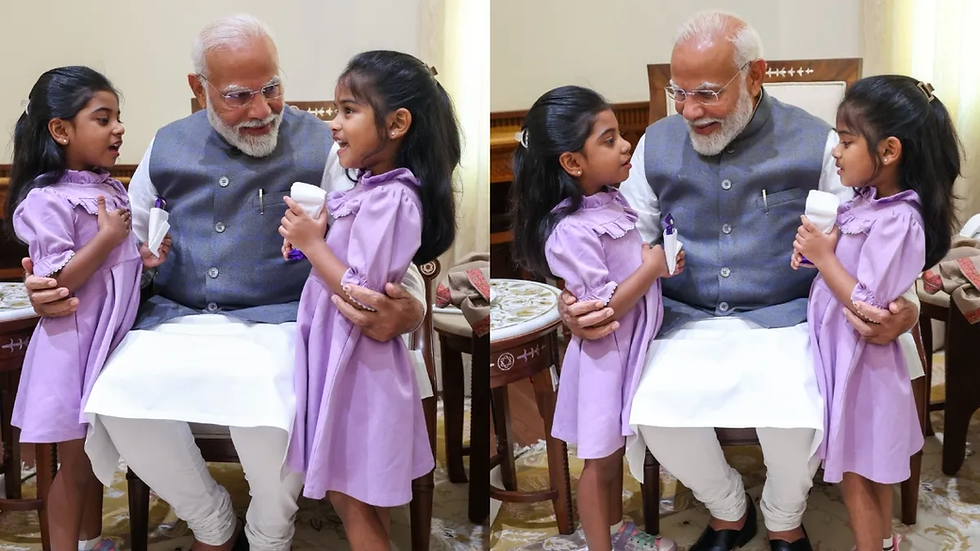Distorting Narratives: Why Hinduism and Modiji Are Unfairly Targeted
- MGMMTeam

- Sep 15
- 4 min read
In today’s polarized world, political leaders and ancient faiths are easy targets for propaganda. In India’s case, Prime Minister Narendra Modi and Hinduism are often attacked together. These attacks rarely arise from genuine academic study or balanced critique; instead, they are rooted in ideological hostility, selective quoting, and an attempt to demean Hindu identity.
Websites like Muslim Skeptic have published pieces such as “Religious Roots: Hindu Incest” and “Kumbh Mela: Hindu …”, both designed not to educate but to provoke. Their method is simple: take Hindu scriptures or festivals, strip away their context, and paint them as backward or immoral. Such writing, amplified by biased commentary, creates a distorted image of Hinduism and by extension of Modiji, who is seen as a cultural symbol of Hindu pride.

Misrepresentation of Hindu Scriptures
The “Incest” Claim
In the article “Religious Roots: Hindu Incest”, Hindu texts are mischaracterized as promoting incest. This is not only misleading but academically dishonest.
Allegory vs Literalism Hindu scriptures, especially the Puranas and epics, often employ allegory and myth to communicate spiritual truths. For instance, divine unions are symbolic of cosmic principles—Shiva and Shakti representing consciousness and energy, Vishnu’s consorts embodying prosperity and wisdom. To read these allegories literally, without understanding symbolism, is to miss the very essence of Hindu philosophy.
Selective Quoting Critics cherry-pick sensational stories while ignoring the vast corpus of Hindu dharmashastras, Upanishads, and Bhagavad Gita, which emphasize ethical conduct, family harmony, and self-control. Hindu philosophy explicitly teaches that dharma (righteousness) is the foundation of life.
Double Standards Every major religion has difficult passages in its early texts. Scholars generally interpret them with nuance. But when it comes to Hinduism, critics abandon nuance and use literalist readings as weapons. This selective treatment exposes the agenda.
Attacks on the Kumbh Mela
The Kumbh Mela, the world’s largest peaceful gathering, is also a favorite target of distortion. The Muslim Skeptic article on the Mela paints it as a regressive, problematic event rather than a spiritual celebration.
What Critics Claim
That the Mela discriminates against minorities (e.g., temporary bans on non-Hindu shopkeepers).
That it represents superstition rather than spirituality.
That it is unfairly privileged by the government compared to minority festivals.
Why These Claims Fail
Cultural Significance Kumbh Mela is not merely a festival—it is a civilizational marker, celebrated for thousands of years. It symbolizes purification, devotion, and unity, drawing people from every corner of India regardless of caste or class.
World Recognition UNESCO has recognized Kumbh Mela as an “Intangible Cultural Heritage of Humanity.” To degrade it is to insult not just Hindus but India’s global cultural contributions.
Communal Provocations Reports show that some controversies—such as disputes over Waqf land or objections to Hindu-only shop zones—are deliberately amplified to create communal tension.
Selective Outrage During COVID During the pandemic, Hindu gatherings like Kumbh Mela were demonized as “superspreader events,” while large processions and gatherings by other communities received muted criticism. This double standard exposes bias, not concern for health.
Modiji as a Convenient Target
A Symbol of Hindu Identity
Narendra Modi has become the face of Hindu cultural pride, both in India and abroad. Because of this, attacks on Hinduism are often packaged as attacks on Modiji himself.
No Personal Scandal Unlike many global leaders, Modiji’s life is free from allegations of corruption, sexual misconduct, or impropriety. Even his staunchest critics cannot accuse him of personal irregularities.
Projection Tactics Critics attempt to destroy Modiji’s image because they cannot elevate their own traditions positively. It is like a student who gets a poor grade and consoles himself by pointing to someone else’s failure.
The Children Photograph Attacks Even images of Modiji with innocent children are twisted by critics to suggest sinister motives. This shows desperation to malign rather than reason to debate.
The Larger Bias Against Hinduism
Selective Outrage
Critics highlight obscure mythological passages to degrade Hinduism but avoid discussing sensitive issues in their own traditions. This is not intellectual honesty—it is deflection.
Ignoring Hindu Diversity
Hinduism is not a monolith. It is a tapestry of philosophies, sects, and interpretations. Picking one story or one practice and branding the entire religion by it is like judging all of Islam by fringe interpretations.
Targeting Festivals, Scriptures, Leaders
By attacking scriptures (through distorted readings), festivals (through selective outrage), and leaders (through character assassination), critics aim at the three pillars of Hindu civilizational confidence.
The MGMM Outlook
In today’s climate of selective outrage, Hinduism and Prime Minister Narendra Modi are repeatedly singled out for criticism that lacks sincerity or scholarly depth. Websites like Muslim Skeptic distort Hindu scriptures by labeling them as promoting “incest” or dismissing festivals like the Kumbh Mela as regressive. These attacks deliberately strip away the symbolism and spiritual philosophy of Hindu texts, ignoring the broader teachings of dharma, self-control, and harmony. Similarly, the Kumbh Mela—recognized by UNESCO as an “Intangible Cultural Heritage of Humanity”—is unfairly vilified as discriminatory or superstitious, even though it has stood for unity, devotion, and civilizational continuity for centuries. During the pandemic, Hindu gatherings were demonized as “superspreaders,” while processions by other communities were excused, revealing the clear double standards at play.
At the center of this narrative is Modiji, who has become a symbol of Hindu pride both in India and globally. Critics, unable to find personal scandals or corruption in his life, resort to character assassination—twisting even his photos with children into baseless innuendo. This pattern shows that the real agenda is not honest critique but an attempt to undermine Hindu confidence by targeting its scriptures, festivals, and leaders. By packaging attacks on Hinduism as attacks on Modiji, detractors reveal more about their own insecurities than about the realities of India’s spiritual or political life.
(Sources: Muslim Skeptic, Times of India, Mathrubhumi, India Today, Business Today, OpIndia, India TV News)




Comments